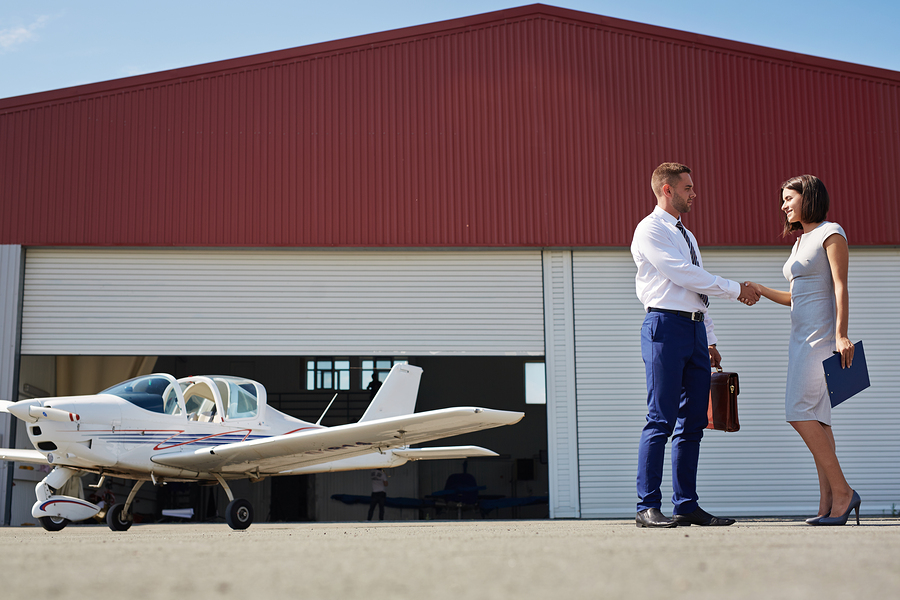The National Business Aviation Association (NBAA): You know it’s an important aviation organization that sponsors the NBAA-Business Aviation Convention and Exhibition (BACE), the largest business aviation trade show in the world. But what benefits does it provide its members, and why should you consider joining as a private or business jet owner — or future owner?
A little history
The NBAA is a trade organization that supports the needs of business jet owners who depend on business and private aviation. It was founded in 1947 to protect private and business aviation interests. Private aviation interest surged soon after WWII: Business leaders were realizing the benefits of flying, and more and more personal operators were cropping up. Organizers understood they had to act quickly to protect the rights of and airspace for private and business aviators; thus, they formed the NBAA with 19 companies as charter members.
Throughout its history, the NBAA has stayed true to its founders’ goal of promoting private and business aviation interests. It has played a role in
- airport improvements,
- enhanced air traffic control regulations and weather reporting,
- improved aircraft and aviation technologies,
- important legislation in the best interests of business aviators, and much more.
Today, the organization has more than 10,000 member companies and has become more global in its scope. It now helps promote and protect aviation interests in the worldwide marketplace. It also provides products and services to those in the business and private aviation industry, including the NBAA-BACE.

NBAA membership
Membership is open to private and business jet owners — whether they own one or many — as well as members of companies involved in the business aviation industry, including aircraft manufacturers, pilots, maintenance professionals, flight operations team members, as well as suppliers and vendors. Levels of membership vary and determine dues and benefits. In addition, those who register their aircraft outside the U.S. can become affiliate members.
Members share their expertise on organizational initiatives with each other. They have opportunities to serve on various committees that address industry causes and concerns. They have access to information regarding industry issues as well as opportunities to advance their managerial skills and careers. Members also receive discounts on events, a free weekly newsletter and monthly trade magazine to stay informed on important news and technologies, as well as the backing of an organization whose members and leaders advocate for them locally and on a national level.
If you would like your organization to become a NBAA member or become one yourself, you or a representative of your business can simply fill out an application.

Standards and resources
The NBAA and its member companies are dedicated to making the skies safer for business aviation. The organization implemented its Flying Safety Award program to recognize outstanding safety records of member companies and their employees. It requires member companies and their pilots, maintenance workers, and others involved in aviation to undergo ongoing training and proficiency checks to help ensure the utmost safety.
 To keep up with their training and stay on top of the latest regulations, requirements, technologies, equipment, and additional information related to business aviation, members have access to a vast array of resources. The NBAA website offers access to information, products, services, social media, podcasts, an events calendar, and a job board. Members can network with each other and gain instant access to expert knowledge, ask questions, and problem solve. They also receive discounts on services such as shipping and aeromedical services, certain events, business development services, as well as insurance and workers’ compensation plans.
To keep up with their training and stay on top of the latest regulations, requirements, technologies, equipment, and additional information related to business aviation, members have access to a vast array of resources. The NBAA website offers access to information, products, services, social media, podcasts, an events calendar, and a job board. Members can network with each other and gain instant access to expert knowledge, ask questions, and problem solve. They also receive discounts on services such as shipping and aeromedical services, certain events, business development services, as well as insurance and workers’ compensation plans.
The NBAA also maintains a member list and recommends you utilize expert services if you are looking to purchase a new or pre-owned jet. They can explain the acquisition process, help you find a good aircraft fit, and guide you through the purchase process, which can be daunting. By purchasing through a NBAA-endorsed member, you can be assured of a well-maintained aircraft, a fair price, and a relatively problem-free buying experience.
 The National Business Aviation Association (NBAA) has been a widely used and respected resource for those in the aviation industry since its founding in 1947. Its members have been involved in major aviation events and rallied around numerous policy changes and movements, tremendously impacting the direction of the industry.
The National Business Aviation Association (NBAA) has been a widely used and respected resource for those in the aviation industry since its founding in 1947. Its members have been involved in major aviation events and rallied around numerous policy changes and movements, tremendously impacting the direction of the industry.
Those looking to join the ranks of the NBAA’s 9,000 member companies, and growing, can look forward to numerous benefits:
A voice in aviation policy — Representation by the leading organization in Washington, which advocates for the betterment of the aviation industry.
Access to knowledgeable experts — Members can receive prompt answers for their most pressing questions from industry specialists via email or phone.
Business management tools — A toolkit that includes the NBAA Compensation & Benchmark Survey, shipping discounts, 10% off the Complete Aeromedical Services Program (CASP), attendance at the NBAA Leadership conference, and more are offered to membership businesses.
Discounts on attendance at industry events — You can attend or exhibit at business aviation events worldwide at discounted rates.
Networking opportunities — Build your contact list at numerous NBAA events, seminars, conventions, and conferences.
Even without a full membership, the NBAA offers a great deal of resources for website visitors, including updates on the latest aviation-related legislation and regulatory matters, information about upcoming events, and numerous free resources covering aircraft operations and flight department administration.
For more information, and to add your company to the growing list of NBAA members, check out the full list of membership benefits and access the application here.
Contact L & L International if you need assistance in purchasing or selling a private jet.You can reach our sales specialists today at sales@L-Lint.com, call us any time at +1.305.754.3313, or visit us online.
The federal government has been working on a new air traffic control system with the goal to get planes in the air and on the ground faster, and more efficiently. The system is called NextGen, and it has been developed with multiple federal agencies and NASA.
On July 15, NASA presented the FAA with a new software for managing the spacing between planes as they approach for landing. It will reduce the number of course and altitude changes required by pilots as well as the amount of communication necessary between controllers and pilots. The end result of the switch from ground-based air traffic control to satellite-based air traffic control should be aviation fuel savings, better airplane flow at busy airports, and greater safety.
What will NextGen mean for private aircraft pilots?
The National Business Aviation Association (NBAA) believes that the NextGen air traffic management program will be beneficial for business aviation, including boosting airspace capacity for everyone, but there are many issues still to be resolved. Some of the issues include the costs, what service operators can expect to receive after installing the NextGen technology, and what it means for operators.
Potential issues for the BizAv market
The FAA needs to level flight standards “when it comes to allowing business aircraft to be certified for the same sorts of procedures as commercial airlines” said Steve Brown, NBAA’s COO. In addition, business aviation is a mixed equipage environment, so the FAA must implement procedures that are usable by business aviation operators.
Another potential issue is the fact that only 10% of aircraft have the necessary equipment installed right now. Whether private jet owners will be able to get the technology in order before an implementation deadline is unclear. While no deadline has been imposed yet, if a jet owner can’t get it installed they may not be able to fly in certain areas.
Timing of NextGen
The FAA has plans to put the new software into its first airport in 2018 if it gets the money from Congress. The target airport hasn’t been picked yet, and money is not a given in Washington these days, so it could be a while before NextGen impacts the business aviation market.
“At the end of the day, whether you’re a military general, an airline ops guy, or a company with a business aircraft, you’ve still got to have a business case that makes sense to you,” says Steve Brown.
Contact L & L International if you need assistance in purchasing or selling a private jet.
You can reach our sales specialists today at sales@L-Lint.com, call us any time at +1.305.754.3313, or visit us online.
More than 25,000 people attended the 66th annual National Business Aviation Association convention in Las Vegas this year. The convention is the world’s largest gathering of members of the business aviation industry. The three-day event included over 1,000 exhibitors and more than 80 aircraft were on display. This is always an exciting event for the bizav industry, and this year was no exception as several new products and innovations were introduced.
Let’s look at some of the innovations that were on display at this year’s show:
- Dassault unveiled their highly anticipated Falcon 5x at this year’s show. The company believes this new plane will become the new standard in business aviation. The plane, which includes an industry-first skylight over the entry, can be ordered now for $45 million. This is Dassault’s first new private jet design in over a decade.
- The Falcon wasn’t the only new plane debuted at the 2013 NBAA show. Eclipse Aerospace introduced their Eclipse 550 plane, a private jet for under $3 million — and the only one available at that price in production today. It’s also the most fuel efficient twin-engine jet currently on the market.
- Gulfstream displayed their Elite interior in their G550. The Elite interior includes a high-definition entertainment system, lighting, and temperature all controlled by an iPod touch or app on the user’s mobile phone. Even the seats received an upgrade, with heated seat massage and powered back and leg rests.
While these innovations were exciting, industry leaders also took time to discuss the future of the bizav industry. While all indictors are that sales should be taking off, uncertainty in the world’s current economy is causing business buyers to hold off on jet purchases. However, manufacturers are seeing more purchases from private buyers, and those numbers are only expected to go up.
It wasn’t all business, though. The NBAA also raised $440,000 for the Corporate Angel Network at this year’s event. This non-profit provides free private flights for cancer patients who are seeking treatment in areas around the country. These treatments could improve the patient’s chances of survival, and the organization removes the financial burden from expensive flights. The NBAA raises money for the organization at the show every year.
All in all, this event was a great success. We’re looking forward to seeing the new products and technologies that were on display come to life in the bizav market. If NBAA 2013 was any indication, it looks like 2014 will be an exciting year for the industry!
Last month, the IRS delivered a final ruling prohibiting certain tax deductions for the entertainment use of business aircraft. The new limitations apply to any tax years after Aug. 1, 2012, and include expenses like fuel, landing and hangar fees, pilot salaries, depreciation, and interest.
Industry organizations like the National Business Aviation Association (NBAA) are expressing dissatisfaction with the new regulations, insisting that they are “administratively burdensome,” and that they have “produced unfairly skewed disallowances for many taxpayers.”
To help aircraft owners understand the new ruling, the NBAA is holding the NBAA Tax, Regulatory and & Risk Management Conference, Oct. 28-29, 2012, in Orlando, Fla. The event includes a well-timed session on strategies and tips to help aircraft owners mitigate any negative tax implications that may have cropped up following the final IRS ruling.
If your organization has previously filed deductions for the entertainment use of your private aircraft — regardless of whether the aircraft is leased, chartered, or owned outright — be sure to seek the advice of a qualified tax adviser to help you navigate the complex new regulations.
Read the new regulations.
Thanks to some hackers, the protection offered by the BARR program will soon disappear. Since airplane registration numbers are a matter of public record, everyone will soon be able to find out who is flying where and when.
What is BARR?
The Block Aircraft Registration Request (BARR) program allows aircraft owners and operators to opt-out of having their flight information broadcast on the Internet in real time. Websites like flightaware.com make it easy to track commercial flights and private flights that haven’t registered with BARR.
What is openBARR.net?
The site openbarr.net enables anyone to track any flight in real time, even if it has requested to keep its flight information private. All you need is an Internet connection and the tail number to keep tabs on the location of a plane. This website was announced at DEF CON, a hacker’s conference, in Las Vegas at the end of July.
What are ramifications of openBARR.net?
I’m sure TMZ and other celebrity “news” sites think it’s about time they have access to this valuable information. However, tracking flights mid-air is an infringement on privacy, and that affects every U.S. citizen. So nobody really cares when and where I fly, but if I hop on a commercial flight, nobody is the wiser. I’m just one of dozens or hundreds of passengers. But a private jet with familiar tail number (can you guess who N236MJ belongs to?) will soon be trackable in real time for all the over-zealous fans and reporters to mob at the landing.
But enough about celebrities. The openBARR.net will have huge effects on business. Interested parties can see where CEOs fly and potentially break up a big business deal or merger. Forget about confidential negotiations.
So what can we do to combat openBARR.net? Share your thoughts with us.
At the upcoming NBAA convention in Orlando, Fla., Oct. 30-Nov. 1, Nexa will present its fourth and final installment in a study commissioned by the NBAA. These Business Aviation User Studies evaluate the success of businesses that use business aircraft and those that do not.
You can read the first three installments here:
So what do expect from this fourth installment? Nexa examined businesses and their performances throughout the recession.
“My expectation is that the companies that have survived and in some cases thrived during the downturn will probably be those that realize that [the business jet] was a critical tool in their tool chest and they used it wisely,” NBAA President Ed Bolen told AIN.
In Part 2, the researchers made three observations about companies that use business jets:
- They performed better financially.
- They weathered the Great Recession better.
- They had better access to customers and markets.
Tell us what you think. Justify your jet, and be proud of it!
You’ve just scored a great deal on a private aircraft for your company, and you’ve locked in the financing. You’ve outlined the business case behind the purchase and presented it to your organization’s key players. Now what?
Any company using private air travel benefits from the member services of the National Business Aviation Association (NBAA). The 65-year old organization pursues a mission “to foster an environment that allows business aviation to thrive in the United States and around the world.”
The NBAA seeks to enable the business community to be more productive and profitable through the promotion of private air travel. Through the organization’s efforts, business travelers benefit from improved aircraft and airport safety and from technological advances in both weather reporting and air traffic navigation.
The organization also strives to help members contend with the complex landscape of business aviation, including advice on tax issues, insurance and risk management, and safety compliance.
NBAA supports its 8,000+ members with more than 100 services:
- Legislative advocacy for the business aviation community at the federal, state and local level
- Continuing education and training through the annual NBAA convention, regional seminars and online forums
- Networking opportunities, both in-person and online, that bring the business aviation community together to share advice, opportunities and solutions
- Direct access to leading aviation experts who can explain the complex rules and regulations surrounding the industry’s certifications, equipment and service specifications, and safety issues
- Industry news, perspectives and information through a bi-monthly magazine, eNewsletter, handbooks and more
NBAA annual membership rates are based on company revenue and aircraft size. To learn more about this important resource organization, visit www.nbaa.org.
Much has been made of the Obama administration’s plan to reorganize funding for air traffic control. General aviation has always paid for air traffic control through a fuel tax. Now, Obama plans to change that to a flat fee — $100 per flight.
This proposed fee, projected to raise $11 billion before 2022, was unveiled Sept.19, 2011. Every flight within controlled air space will be required to pay the fee, with the following exceptions:
- Recreational piston aircraft
Immediately after the proposed fee was announced, general aviation groups cried foul. The backlash comprises a few major arguments:
- General aviation already pays for air traffic control with fuel tax.
- Government should encourage general aviation as an economy-builder rather than adding fees.
- More bureaucracy would be needed to collect the fee.
Some 9,000 individual opponents to the suggested $100-per-flight fee signed a petition demanding the White House drop the proposal. They received their answer on Friday, Jan. 13, 2011, when the associate director of general governmental programs, Dana Hyde, repeated the White House opinion that the fee is necessary for air traffic control.
What do you think? Does the fee level the playing field or unfairly target business aviation? Does the current fuel-tax system work?
The media and general public may not understand the value of private aircraft, but successful businesses do. Private jets are not for show and comfort. Rather, they are an important — often indispensable — tool in the battle for business, especially as many companies are fighting their way out of recession.
Frequent business travelers say private aircraft offer several advantages.
- Provide more time to spend with family
- Reach numerous destinations quickly
- Eliminate common safety issues associated with commercial flights
Better efficiency, better business
Even beyond these practical advantages, private aircraft deliver measurable ROI for the businesses that use them. According to the study Business Aviation: An Enterprise Value Perspective — The S&P 500 from 2003-2009, private airplane users outperform non-users in revenue growth, profit growth and asset efficiency.
The study demonstrates that, compared to non-users, private aircraft users
- see 116 percent higher average annual revenue growth
- realize 434 percent higher annual earnings growth
- average 81 percent higher annual earnings before interest and taxes
- see 496 percent higher market capitalization growth
Whether before, during or after the significant decline in the business aviation market in 2008, business jet users substantially outperform non-users in nearly every analyzed financial category.
Jet market continues to rebound
Business executives who understand these advantages continue to invest in private aircraft. The private jet industry has certainly experienced its share of turbulent weather during the recession and the slow, ongoing recovery. However, many experts believe the worst is behind it, according to a May 2011 New York Times report.
In the report, Richard Aboulafia, an aviation analyst at the Teal Group in Fairfax, Va., says, “The overall market has stopped falling, and 2011 deliveries are likely to be about level with last year. For next year, leading indicators are pointing to renewed growth, with the pool of available aircraft in the used jet market shrinking, although prices for used planes are still soft.”
The New York Times report also notes that typically, as recovery sets in, returning buyers first hunt for bargains on pre-owned planes and then start to look at new models. Experts at L&L suggest that if you will be in the market for a pre-owned jet soon, you might begin looking now.



 To keep up with their training and stay on top of the latest regulations, requirements, technologies, equipment, and additional information related to business aviation, members have access to a vast array of resources. The NBAA website offers access to information, products, services, social media, podcasts, an events calendar, and a job board. Members can network with each other and gain instant access to expert knowledge, ask questions, and problem solve. They also receive discounts on services such as shipping and aeromedical services, certain events, business development services, as well as insurance and workers’ compensation plans.
To keep up with their training and stay on top of the latest regulations, requirements, technologies, equipment, and additional information related to business aviation, members have access to a vast array of resources. The NBAA website offers access to information, products, services, social media, podcasts, an events calendar, and a job board. Members can network with each other and gain instant access to expert knowledge, ask questions, and problem solve. They also receive discounts on services such as shipping and aeromedical services, certain events, business development services, as well as insurance and workers’ compensation plans.
 The National Business Aviation Association (NBAA) has been a widely used and respected resource for those in the aviation industry since its founding in 1947. Its members have been involved in major aviation events and rallied around numerous policy changes and movements, tremendously impacting the direction of the industry.
The National Business Aviation Association (NBAA) has been a widely used and respected resource for those in the aviation industry since its founding in 1947. Its members have been involved in major aviation events and rallied around numerous policy changes and movements, tremendously impacting the direction of the industry.